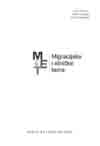Doseljavanje stanovništva iz slovenskih krajeva u Čabarski kraj na temelju zabilješki u knjigama Status animarum
The Immigration of People from Slovenian Regions to the Čabar Region Based on the Notes from Ecclesiastical Status Animarum Books
Author(s): Barbara RimánSubject(s): Social Sciences
Published by: Institut za migracije i narodnosti
Keywords: Status Animarum; Čabar region; Gorski kotar; Slovenian population immigration
Summary/Abstract: The area of Gorski kotar was in history a site with a variety of migratory processes which influenced the ethnical particularities of that area. These migrations were the reason for the heterogeneous composition of the present population of the Gorski kotar region. The Čabar region was not an exception to this, and throughout history there existed a written record of the immigration of people from all over the Habsburg Monarchy. Especially intensive was the immigration in the areas situated near the Kupa and Čabranka rivers. The reasons for immigration and for its intensity can be seen in the notes written down in the church books named Status Animarum (cro. Stanje duša, slo. Družinske knjige). The immigration or emigration reasons of individuals as well as of whole families have been noted in these books. On the basis of these notes we can draw conclusions regarding the level of generalization for the precise geographical area and the precise political and historical period, which becomes a relevant and credible basis for theoretical considerations and a comparative analysis. In this manner, the history of the geographical area becomes the history of the area’s residents, both those permanently inhabited and those who settled subsequently. This paper will focus on the immigration of people in the Čabar area from present-day Slovenian regions during the 19th and 20th century. The data obtained from the Status Animarum books, which were written in the parishes of the Čabar region, show the immigration of people, which proves migration from Slovenian regions to the Croatian ones, but also vice versa. The conclusions of the paper will be illustrated and backed with data obtained from the Status Animarum books originating from Slovene parishes Babno Polje and Jelšane, and with additional information from elementary school registers in Prezid and Čabar.
Journal: Migracijske i etničke teme
- Issue Year: 2013
- Issue No: 1
- Page Range: 63-88
- Page Count: 26
- Language: Croatian

